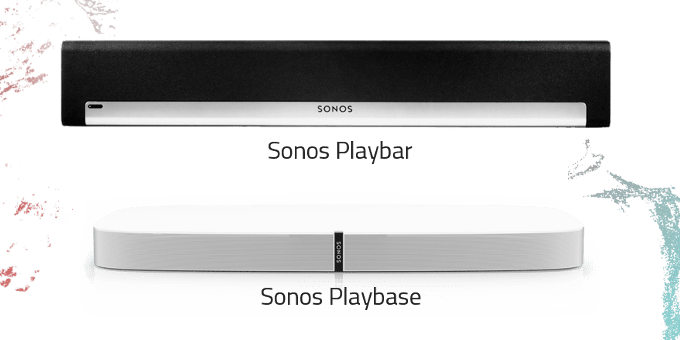Looking for ultimate sound experience? Us too! Lot’s of modern day TVs feature beautiful depth of color and thin shape while totally missing the mark on sound quality. So we end up looking for high-quality speakers to complement our high-def TVs. But guess what — Sonos can make our 4K TVs sound as good as they look.
Choosing between Sonos Playbase vs. Playbar is like choosing between a chocolate chip cookie and a brownie, or ice cream and gelato. It’s not an easy choice. After all, it’s not only about preferences, it’s also about the details. So, today we’ll take a closer look at Sonos Playbase and Playbar features & specs to help you choose the right speaker for your home.
About Sonos Speakers
With Sonos speakers you can fill every room with music. Do you want to play different songs in different rooms? Not a problem. Sonos offers wireless control of all Sonos speakers via one app. You can stream from Spotify, Pandora, Apple Music, you name it. There are over 50 music services to choose from, and the best part is that the list of streaming partners just keeps growing.
Getting the Sonos Playbase or Playbar is just the beginning of an exciting journey towards the ultimate home theater experience. You’re getting the base, which you can extend into a complete 5.1 home theater system with zero drama because Sonos has everything you need to set it up. Just add the Sonos Sub for soul-shaking bass and a pair of PLAY:1, PLAY:3, or PLAY:5 speakers for L/R rear channels. And that’s it — watching Netflix will never be the same again.
Sonos Playbase vs. Playbar — Things in Common
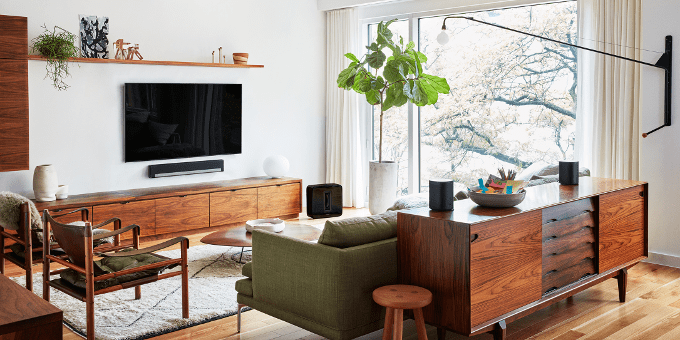
Both the Sonos Playbase and Playbar combine a full-theatre sound system and a streaming music speaker in one device. You can enjoy cinematic sound for all your favorite movies, TV shows, sports, and games or stream music wirelessly, it’s up to you.
The Playbase and Playbar use WiFi over Bluetooth since WiFi delivers clear music stream without interruptions or interference. After all, who wants their favorite music track to cut and stutter?
The Sonos Playbase and Playbar offer quite a few options for remote control: via Sonos app, IR remote, or voice. All Sonos speakers work well with Amazon Echo devices, so you can use your voice to play and control songs, playlists, radio stations, podcasts and more.
Both Playbase and Playbar also come with a few useful features for watching TV: speech enhancement and night mode. The speech enhancement feature reduces the volume of any loud sound effects to deliver crisp, clear dialog. And the night mode is perfect for watching TV late at night because it balances out the sound by enhancing quiet sounds and reducing the intensity of loud sounds.
Also, both Playbase and Playbar feature Trueplay — a calibration software that fine-tunes the sound to fit the space by measuring the size, shape, and setup of your room. After all, speaker placement can be far from ideal when using the space you have rather than setting up your entertainment room from scratch.
With Trueplay, everything counts: the speaker position, makeup of the room, sound reflection off walls, furniture, etc. Calibrating all this data helps Sonos speakers provide the purest sound possible in your particular setup.
As of now, the Trueplay feature is only available for iOS users. It’s a one-time setup, so in case you’re from the Android crowd, you can invite an iPhone-owning friend around to use their device for a couple of minutes in exchange for popcorn and a movie. Because who says no to popcorn and a movie?
The speakers connect to your TV via a digital optical cable, so make sure your TV has a vacant slot for it. Other than that, installation is a breeze. You can set the speaker up over WiFi in just a few minutes from your iOS or Android smartphone.
With the Sonos Playbase and Playbar, you can play everything: cable and satellite boxes, gaming consoles, and blu-ray players. As long as it’s connected to your TV, both the Sonos Playbase and Playbar will play it.
And now let’s move to the part where we help you choose between the Sonos Playbase vs. Playbar by outlining the differences between the two speakers.
Sonos Playbase vs. Playbar — Differences
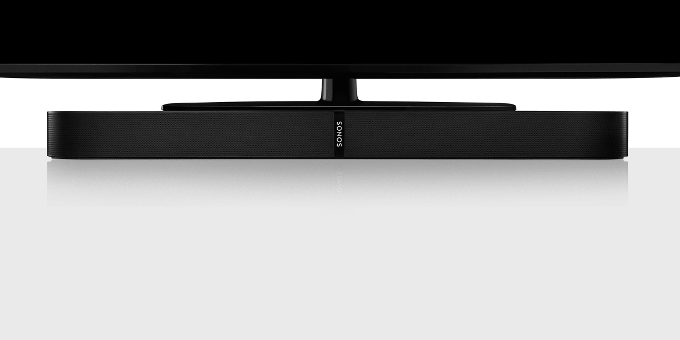
Difference #1: Sound Quality – The Playbase comes with ten amplified speaker drivers whereas the Playbar is a nine-driver system. Although Sonos Playbase and Playbar have six mid-range and three tweeters, the Playbase also comes with an S-shaped woofer.
The woofer allows the Playbase to produce more natural deep notes. The Playbar, on the other hand, doesn’t have a woofer which results in more monotonal sound of the the bottom end.
And even though the Playbase is superior due to it’s added woofer specs-wise, when it comes to actual testing the Playbar sounds a bit better than the Playbase.
In our experience, the Playbase, with its S-shaped woofer, produces rather sibilant sound that distracts and detracts from the whole sound picture whereas the Playbar produces a little softer and less enthusiastic deep notes. The Playbar has also more control in the treble which results in an overall more enjoyable listening experience.
Difference #2: Airplay 2 – Only a few existing Sonos speakers will support Airplay 2 (which is coming later this year), and the Sonos Playbase is one of them. With its latest hardware, the Sonos Playbase has enough processing power to support Airplay 2.
Unlike the Playbase, the Sonos Playbar will not support Airplay. However, you can still bring Airplay support to your Playbar by grouping it with one of the Sonos Airplay-enabled speakers, like the Sonos ONE or PLAY:5.
Difference #3: Ethernet Port – The Playbase has one Ethernet port whereas the Playbar comes with two 10/100 Mbps Ethernet ports. Why would you need two of them? Well, you can use one port to connect the Playbar to a wired home network and the other port to bring standard Internet connectivity to other devices. So, with an extra Ethernet port you can connect a Smart TV or a Roku box to your LAN and the Internet which contributes to smooth and uninterrupted streaming experience.
Difference #4: Color – The Playbase is available in two colors: black & white whereas the Playbar comes in black only.
The black color blends perfectly with modern TVs, however, with the white color you can really complement certain TV setups. So, with the Sonos Playbase speaker, you can make sure the new sound system blends in seamlessly with your home’s décor.
Difference #5: On-Device Controls – Besides remote control via the Sonos app, Amazon Alexa or an IR remote, the Sonos Playbase and Playbar also feature on-device control.
The Sonos Playbase has three touch-interface buttons on the front side of the speaker for volume, track change, and play/pause.
The Sonos Playbar has side panel buttons for volume and play/pause. Unlike Sonos Playbase, the Playbar’s buttons lack touch interface which adds to an overall sleeker look of the speaker.

Difference #6: Mount Options – The Sonos Playbase features an off-the-wall approach to better TV sound, which is perfect for people whose TVs end up on stands and furniture. The Playbase can securely support TVs up to 77 lbs (35 kg). Just place the Playbase beneath your TV for a beautiful, low-profile design and epic home theatre audio.
The Sonos Playbar, on the other hand, sounds best when mounted on the wall. However, you can also place it beneath your TV, on a table or console since it has rubberized ‘feet’. The only problem with placing it on a piece of furniture is that in the standing position the drivers are facing upwards rather than forwards, which can really impact the sound in a bad way.
So, when it comes to placement of Sonos speakers, you get more options with the Playbar than with the Playbase due to available wall-mount support for the Playbar.
Difference #7: Design – One of the major differences between the Sonos Playbase vs. Playbar is their dramatically different design.
The Sonos Playbase has a flat and slim rectangular shape with rounded edges to slip directly beneath a TV set. It measures at 720mm wide and just 58mm tall.
The Playbar, on the other hand, features a long shape measuring 900mm wide by 140mm high. It’s perfect for wall-mounted TVs since you can mount it to the wall right underneath your TV for a
beautiful look and sound.
Sonos Playbase vs. Playbar — Comparison Chart
| Sonos Playbase | Sonos Playbar | |
|---|---|---|
| Mono Output | No | No |
| Stereo Output | Yes | Yes |
| Class-D Digital Amplifiers | 10 | 9 |
| Tweeter | 3 | 3 |
| Mid-Woofer | 6 | 6 |
| Woofer | 1 | – |
| Adjustable Bass & Treble Controls | Yes | Yes |
| Audio line-in | No | No |
| Connect to TV | Via Digital Optical Cable | Via Digital Optical Cable |
| Voice Control over Amazon Alexa | Yes | Yes |
| Amazon Alexa Built-In | No | No |
| Airplay 2 | Coming this year | No |
| Trueplay | Yes | Yes |
| Set Up Over WiFi | Yes | Yes |
| Humidity Resistant | No | No |
| WiFi | 802.11b/g, 2.4 GHz | 802.11b/g, 2.4 GHz |
| Bluetooth | No | No |
| Ethernet Port | 1 | 2 |
| Size | Medium | Big |
| Dimensions | 2.28 x 28.35 x 14.96 in. (58 x 720 x 380 mm) |
3.35 x 35.43 x 5.51 in. (85 x 900 x 140 mm) |
| Weight | 18.85 lbs. (8.6 kg) | 11.9 lbs. (5.4kg) |
| Product finish | Black or White | Black |
| Button Control | No | Yes |
| Touch Control | Yes | No |
| One App Control | Yes | Yes |
| IR Control | Yes | Yes |
| Dialog enhancement | Yes | Yes |
| Night mode | Yes | Yes |
| Wall Mount | No | Available |
Sonos Playbase and Playbar Accessories
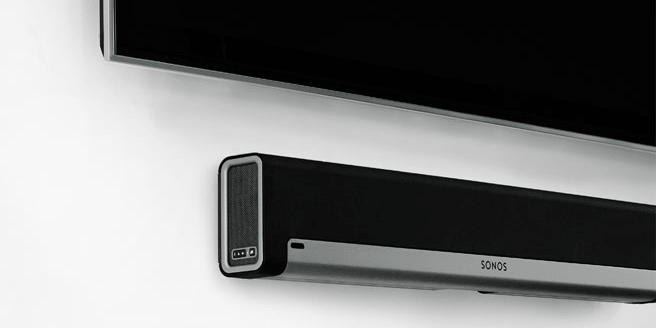
If you’re looking for flexible control of your TV and Playbase setup, we’d highly recommend checking the custom-designed, swivel-action base. The base can securely hold & hover your TV up to 8” above the Sonos Playbase. Plus, with the base, you can swivel your TV up to 20° right or left so that no matter where you are in the room, you can still get a pretty good view angle.
And in case you decide to go with the Playbar, make sure to get the wall mount. With the wall mount you can place the Playbar horizontally above or below your TV for a better sound performance.
Sonos Playbase vs. Playbar — Our Thoughts
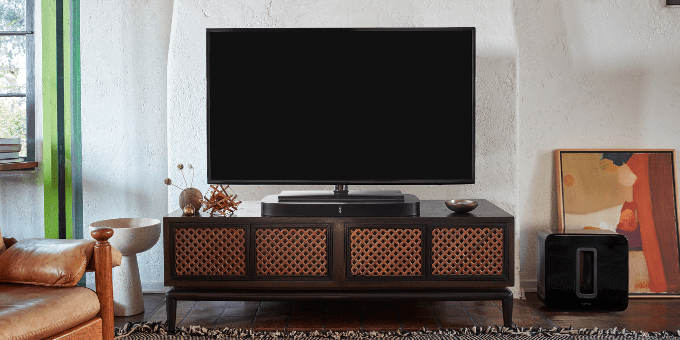
Both the Sonos Playbase and Playbar are very similar when it comes to remote control and installation. You can control the speakers via the Sonos app, Amazon Alexa, IR remote or even use the on-device control when you happen to pass by. The speakers connect to your TV via a digital optical cable and will stream and play anything and everything as long as it’s connected to your TV or comes from your Sonos app.
So, when it comes to choosing between the Sonos Playbase vs. Playbar you need to consider a few factors:
- Existing placement of your TV;
- Availability of other devices for Internet connection via an Ethernet cable;
- Future plans on extending to 5.1 sound system.
The Playbase is perfect for TVs that sit on furniture whereas the Playbar is a great choice for wall-mounted TV. Unlike Playbase, the Playbar comes with two Ethernet ports. So, if you have a Smart TV or a Roku box, the Playbar is better option for you since you can provide stable Internet connection with no interference whatsoever.
The Playbase has more drivers than the Playbar — 10 vs. 9. So, if you’re looking for a standalone purchase, we’d recommend going with the Playbase since you can get more sound from deeper notes. However, if you’re looking to extend your sound system to 5.1 eventually, then it means you’ll buy a Sonos Sub which will more than compensate the Playbar’s missing woofer.
After all, it’s all about sound quality, and it heavily depends on your room makeup. Even with the Trueplay software, there are still quite a few things that can influence the sound dramatically. So, since Sonos offers a 45 day return policy, we highly recommend testing both Playbase and Playbar in your particular setup and then return one of them.
It’s very pricey to order them both, however, at the end of the day you’ll have the perfect sound system in place to fill your home with rich, crystal clear sound for music, podcasts, movies, video games, and much more.
Last update on 2024-04-18 at 16:01 / Affiliate links / Images from Amazon Product Advertising API
